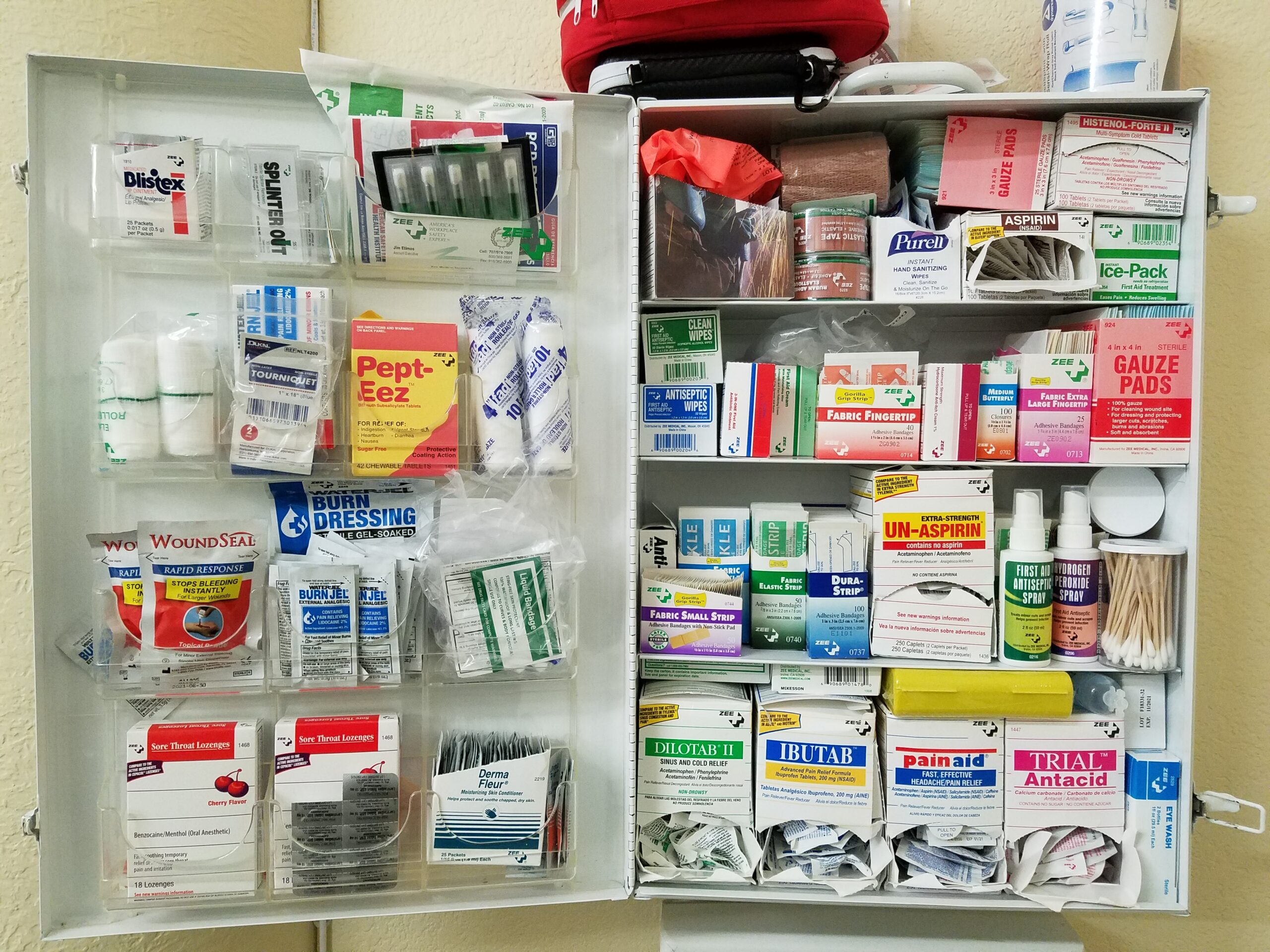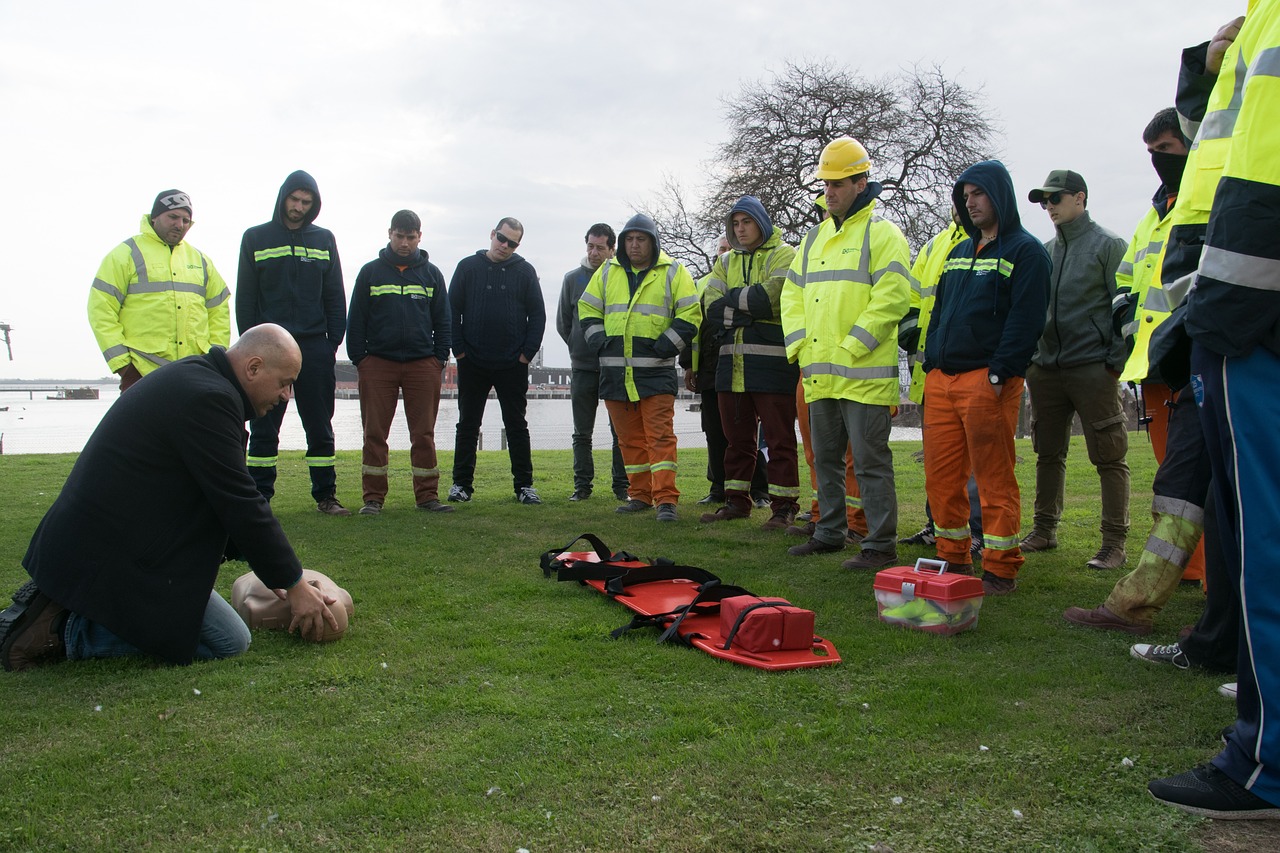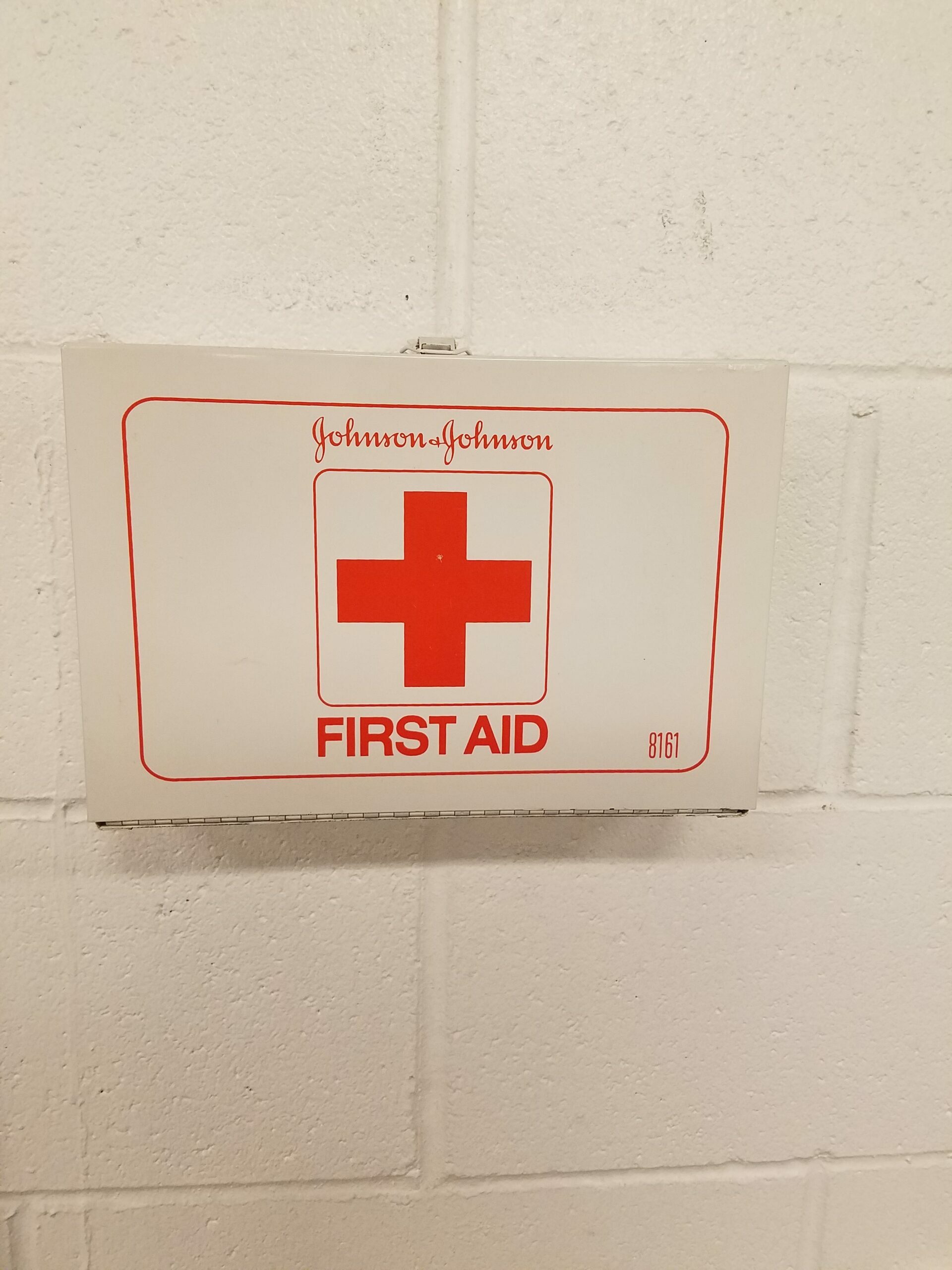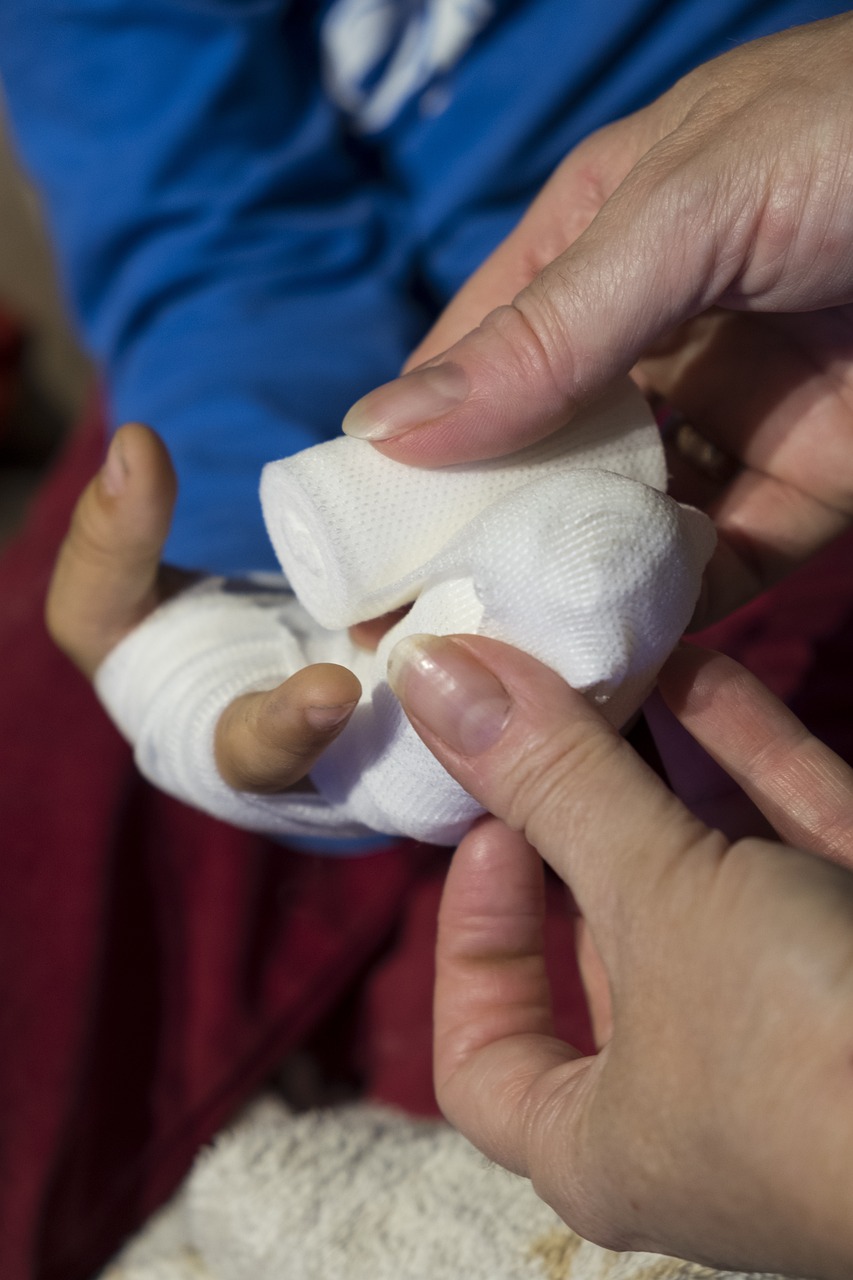We may earn money or products from the companies mentioned in this post, but this does NOT cost you anything extra! Check out my full disclosure for more info.
Updated: 2/18/24
I’ve always had a blast putting together first-aid kits, from tiny mint tin ones to larger kits for multi-day hikes with a buddy.
Having top-notch supplies on hand can be a game-changer in an emergency.
Today we will set you on the right path to creating your first aid kit.
Remember, it’s all about taking that first step – you can always add more items later!
Essential – Every Kit Should Have
I feel everyone should have this basic checklist of the necessary items.

I am not putting the amount of each item you need. This is because all of our situations are different.
If you are by yourself, you might only need a few of each, but if you are a family of five, you better have more than one or two of each item listed.
- Tweezers
- Safety pins
- Sterile gloves
- Gauze dressing
- Alcohol prep pads
- Adhesive bandages
- Antibiotic ointment
- Medication for you or your family
Other Considerations – Always Nice to Have
If you have some extra space or feel like expanding on the list above, there are a few more things you might like to keep handy.
As you can guess, some of these items may overlap with what’s already mentioned, such as medication, but again, your kit should be specific for you and your family.
Speaking of that, remember that having the right training and knowing how to use the items in your kits is crucial.
For example, if you possess specialized items like blood-stopping tools or splints, you must know how to use them properly.
I’ve encountered individuals with items in their kits that they can’t even identify!
You might think it’s okay because you will be with knowledgeable people, but what if you’re alone?

Taking a basic first aid course is always advisable to combat this, which can be incredibly beneficial.
So, considering all this, and depending on your room, let’s return to a list of items.
- Aspirin
- Ibuprofen
- Sugar tables
- Throat lozenges
- Diarrhea medication
- Sunburn gel or spray
- Blood-stopping gauze
- Finger splint
- Tourniquet
- Eye drops
- Liquid bandage
For those of you who want one piece of gear that has proven to be a game-changer, that is Leukotape.
This stuff can handle it all – from fixing gear to soothing blisters. Seriously, if you don’t have any yet, get yourself some pronto!
You can thank me later.
I keep extra Leukotape on trekking poles, a small lighter, and, of course, my first aid kit.
This tape is so amazing that on hikes I even ditched my usual KT Tape and Moleskin that I always carried around to lighten my pack. KT and Moleskin sill have a place, but for a general hike, I leave them behind now.
Tools and Supplies
I have a confession to make – I’m a bit of a tool enthusiast. Whenever I bring in a new gadget, my colleagues are eager to check it out.

It’s exciting to explore the latest equipment, do some research, and discover its capabilities.
Whether you’re on the road or out in the wilderness, having the right first aid tools and supplies is crucial.
They can come in handy during emergencies and ensure your safety.
While most of these items may seem like common sense, I felt it was necessary to highlight their importance in this list.
- CPR mask (they also make a disposable sheet kind)
- Knife (or better yet, a multi-tool with pliers)
- A needle (and a small amount of thread)
- Scissors (like the Leatherman Raptor)
- Black permanent marker
- Emergency blanket
- Pen or black marker
- Paper or a notepad
- Hand sanitizer
- Safety pins
- Wet wipes
- Tweezers
Be Ready For What Might Happen
So far, each item above has the potential to be a standalone article, delving into each item in detail with numerous examples provided.
Instead, I intend this article to provide you with a foundational guide for assembling your first aid kit, aiming to be concise yet informative.
Just remember to be familiar with what is in your kit.

For example, if you have a tourniquet, you better know how to use it and remember to document when it was applied.
As someone who always tried to be prepared for what might happen, you might have guessed that I have a few first aid kits at the ready.
For example, when I go for a day hike or a longer backpacking adventure, I make sure to have separate kits ready.
Similarly, during my epic road trips, I carry a bigger kit that restocks the smaller ones and keeps everything organized in one spot.
Here are a few ideas of kits you might want to have too:
- Day hike and three-day hiking trips
- Travel kit (which is smaller and TSA compliment)
- Large kit for home use (also the one I use to restock the others)
- Two separate kits in my vehicle (the larger one in the back and a small one in the glove box)
- This might not apply to you, but I have a few packs for work (I have a large bag with many supplies in the truck, one next to me in the driver’s seat, and always a tourniquet on my person, which is due to being a first responder).
What’s In Your Kit?
Having various kits on hand is really handy because it can be a hassle trying to decide what to pack for a particular trip.
What I’ve discovered is that having specialized kits ready to grab and go is the way to go. This is mostly because certain items like knives and scissors are not allowed on flights, and I’ve even had TSA confiscate my tweezers before.
Plus, I prefer not to lug around unnecessary stuff when I’m out hiking, especially at high altitudes. That’s why I always have my trusty bare-bones kit with essentials like moleskin, band-aids, wet wipes, and more.
If I left anything out, leave it in the comments below!
Ready to Learn More?
Check out the Staying Prepared section.
Hi, this is a very useful post, thank you. Mountain biking is my passion and I always carry a basic first aid kit. Also as somebody who has trained in first aid, my most recent instructor was a master of using anything available to treat injuries. His instruction was invaluable. Also, I’ve seen too many mtb incidents and discovered that some riders don’t carry first aid kits because they consider them too much to carry or see them as taking up space that might be better filled with bike spares. Others just forget. So, given that many riders are limited on space, what would you suggest as an absolute must? Best regards, Steve C
I love mountain biking! Talk about a good way to get outside and get some exercise. I would agree with you 100% having a basic kit is important but no need to bring a splint…there are always sticks that you can use (assuming you have a way to hold them together). As an absolute must, what I have is a small baggie of meds (for a headache, that would just kill your ride), chap stick, small container with sunscreen, a few different band-aids, gauze, and KT tape. This is in addition to what I have for the bike (extra tube, patch kit, dollar bill for the tire if needed, multi-tool, pump, energy gel, etc.).
Hope that helps.
These are really great lists. I am pretty good in an emergency, however for some reason, I keep forgetting to get a first aid kit together. I think I will get on that this weekend. Thank you for the valuable information and for reminding me to get mine together. Happy Halloween!
That is awesome and thanks for the comment!
Thanks for this information. I really need to work on having a more robust first aid kit at home. I have a small one in our storm shelter, but it could be improved.
It’s always good to have something…better than nothing. Just hope it will help! Thanks for the comment.
Having a properly stocked first aid kit is part of being a responsible adult if you have kids. My son is a Boy Scout and is always putting kits together for around the home and in the car.
Your information here will help a lot of people with their first aid kits.
You are correct in your statement about training, you could do more harm than good if you do not know how to use or when to use the items in your first aid kit.
I like to make my own kits, do you think this is more cost-effective than purchasing a kit already made.
John
Shout out to the Boy Scout’s!
I totally think making your own kit is more cost-effective. I have purchased already made kits and come to find they aren’t always the best of quality…that being said depends on what pre-made kits your looking at. I just like to make sure I have good supplies (none of those plastic band aid things that don’t stick to anything for example). When you make your own you can also ‘customize’ them for your needs. Hope that helps and thanks for reading!
Thanks for this I need to make and carry a first aid kit with me. You never know when it could be useful.
Copy that, I have found I use my kit for others…more than myself.
Hi Eric,
Thank you for a very useful post. We all should always be ready in cases of emergencies. And first aid kit is one indispensable item. This post now triggered the need for us to review our stock of first aid kit. Thanks again.
That is awesome to hear! If you have questions let me know…might give me additional information to write about too. Good luck and thanks for the comment.
Muchas gracias. ?Como puedo iniciar sesion?
Gracias por visitarnos, pero esta es una publicación de blog y no hay nada en lo que “iniciar sesión”. Si está interesado en obtener más información sobre este tema, consulte otras reseñas en el sitio para obtener más reseñas y equipos para actividades al aire libre.